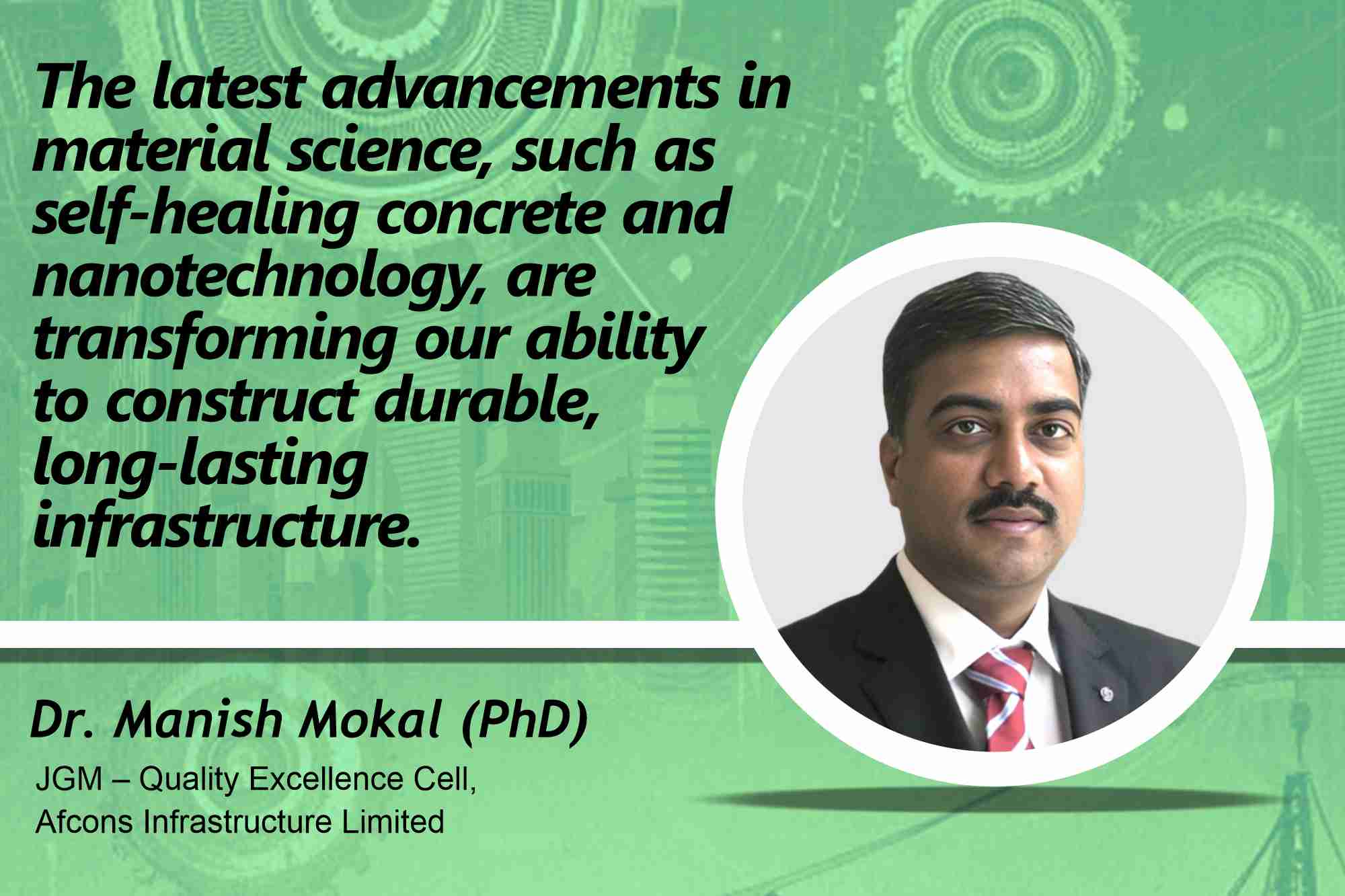Advances in material science enhance construction durability
By Staff Report | October 25, 2024 5:23 pm SHARE

Emerging construction technologies, such as self-healing concrete and nanomaterials, are transforming infrastructure by increasing durability, sustainability, and efficiency. This ensures that current structures can survive environmental problems and future needs.
How are emerging technologies enhancing the durability and resilience of building materials against environmental stressors?
Emerging material science technologies improve the endurance of building materials in the face of environmental stressors such as weather and corrosion. New-generation superplasticisers enable greater replacement of pozzolanic material in concrete, boosting durability. Special additives such as corrosion inhibitors and crystalline waterproofing admixtures significantly improve corrosion resistance, extending the life of structures.
Self-healing materials seals the cracks, nanotechnology-enhanced concrete for strength and water resistance, and smart materials that adjust to temperature changes are all examples of innovation. 3D printing enables stronger, customised components, while recycled materials, such as those derived from demolished concrete and discarded plastics, promote sustainability and resilience. Predictive maintenance with IoT sensors tracks structural health in real-time, enabling preventative repairs. These innovations increase modern structures and infrastructure’s durability, adaptability, and sustainability.
What innovative approaches are utilised to integrate sustainability and energy efficiency into your products or solutions?
Green construction materials such as fly ash, slag, recycled steel, and low-carbon concrete are used in innovative approaches to sustainability and energy efficiency in infrastructure projects, as is renewable energy integration via solar panels and wind turbines. Passive design strategies optimise natural light, ventilation, and insulation, lowering energy use. Smart grids and IoT-enabled systems can monitor and modify energy consumption in real-time, increasing efficiency. Water-saving technologies such as rainwater harvesting and greywater recycling are also used. Green roofs, urban trees, and permeable pavements also enhance the environment by managing rainwater, lowering heat islands, and increasing biodiversity in urban environments.

How do you address the challenges of integrating pre-engineered buildings with existing infrastructure to ensure compatibility and longevity?
Rigorous planning and design coordination are required to integrate pre-engineered buildings (PEBs) with existing infrastructure. Structural compatibility is achieved by conducting extensive site surveys utilising NDT techniques and aligning new foundations with existing systems. Customisable PEB components, such as flexible connections and modular designs, enable easy integration. Attention to utilities—such as electrical, plumbing, and HVAC systems—ensures proper alignment and operation with the current configuration. Material selection prioritises durability and corrosion resistance, improving longevity. Finally, environmental considerations like temperature expansion allowances are evaluated to assure structural integrity and long-term sustainability.
How have innovations in materials and construction methods improved efficiency and durability in Metro Rail and road projects?
Material and building procedure innovations have greatly improved the efficiency and longevity of metro rail and road projects. High-performance concrete, which incorporates supplementary cementitious material and other durability-enhancing additives, provides greater longevity and resistance to environmental stressors, lowering maintenance requirements. Modular construction techniques enable the erecting of prefabricated precast components on-site, speeding construction procedures and reducing interruption.
Implementing Lean Construction techniques such as Root Cause Analysis, Value Stream Mapping, and the Last Planner System saves time, material waste, and non-conformances, resulting in considerable improvements in quality and productivity. Advanced surveying technology, like LiDAR and drones, increases site assessment accuracy, allowing for improved planning and faster project deadlines.
Can you elaborate on how advancements in building materials have influenced the execution of projects like the Bandra-Worli Sea Link and the Rohtang Tunnel?
The Bandra-Worli Sea Link was built with high-performance concrete that included supplementary cementitious material and specific admixtures to offer the strength and durability required to endure harsh coastal conditions and significant traffic loads. To protect against corrosion, the reinforcement was coated with fusion-bonded epoxy. These materials improved the structure’s lifespan and allowed for speedier construction using precast techniques.
In the case of the Rohtang Tunnel, which faces difficult environmental and geological circumstances, innovations such as fibre-reinforced shotcrete and high early-strength concrete proved critical. These materials increased excavation stability while also resisting water ingress and erosion. Special boilers for hot water and steam were integrated into the batching plants to allow uninterrupted concrete production even at subzero temperatures. Using modern tunnelling technologies allowed for greater precision and efficiency in construction, reducing interruption to the surrounding environment.
Could you share insights on how the use of fly ash has advanced the performance and sustainability of concrete in high-profile projects?
Using fly ash in concrete has greatly improved performance and sustainability in high-profile projects. Fly ash, a byproduct of coal combustion is used as a supplementary cementitious material (SCM), substituting a portion of Portland cement with concrete. This substitution improves the material’s sustainability by lowering the carbon footprint of cement production, which is energy-intensive and generates significant volumes of CO₂.
In terms of performance, fly ash makes concrete more workable, making it easier to handle and install. Its small particles help fill holes in the mixture, resulting in a denser and more durable substance. Fly ash also improves long-term strength and resilience to chemical attacks such as sulphate and chloride exposure, making it excellent for infrastructure projects in harsh regions. It also lessens the hydration heat, which helps minimise thermal cracking in large concrete pours such as dams and bridges.
For more information, visit: https://www.afcons.com/en
Cookie Consent
We use cookies to personalize your experience. By continuing to visit this website you agree to our Terms & Conditions, Privacy Policy and Cookie Policy.




































-20240213125207.png)

























